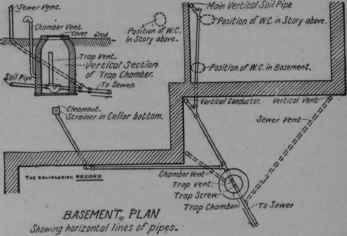Cause Of Stoppage On A House Drain
Description
This section is from the book "American Plumbing Practice", by The Engineering Record. Also available from Amazon: Plumbing: A working manual of American plumbing practice.
Cause Of Stoppage On A House Drain
Allan M. Barrows, architect, Chicago, 111., writes: "Will you kindly furnish me through your valuable journal with a comment upon the scheme of drainage as shown by the sketch inclosed and described herein. A contract for plumbing has been recently executed in a dwelling at Oak Park, 111., in accordance with accompanying sketch. A few days after its completion and during a heavy rainstorm water was found to be overflowing the basement water-closet. An examination quickly made resulted in the discovery that the running trap in the chamber had been chocked full of paper; as also the vent pipe from the trap on the house side. The toilet paper had accumulated at the first bend and the flush from one closet at so short rise had failed to discharge it past the seal dip into the sewer. This stoppage had caused the pipe to fill with rainwater from the leader and back up, overflowing the closet as described.
" The owner in his efforts to locate the blame had called upon the plumber, who, in response to the owner's inquiries, said that he had followed the architect's drawings and specifications, which required the installation of running trap chamber, vent, etc., though contrary to his ideas of good plumbing. He further said that he deemed a trap of any sort placed in the soil drain an unnecessary obstruction, and if this were his job he should remove the trap chamber and all, and insert in its place a straight section. In my next interview with the owner I was subjected to considerable reproach, and it was only through the suggestion that for the present we remove the chief source of danger that the whole system was spared destruction. The rainwater leader was disconnected, and then I suggested that in fairness to me he should consult an expert in this matter. Time has now passed and he has failed to do this, so I have written you asking your opinion which I am aware he will consider authoritative, for my own justification."

[Theoretically, every trap used is an obstruction, fixture traps included; their use is deemed the lesser of two evils. The position of The Engineering RECORD on the need of a trap on main house drains is again explained in the issue of December 2, 1893. From the sketch submitted we should look for the cause of stoppage either in a drain laid without sufficient incline or in some foreign substance caught or lodged in the main trap. Or the basement closet may be set too low and be inadequately flushed, or the drain beyond the rainwater leader connection may be too small to serve the roof area drained in case of a heavy shower. In that case there would be a back flow at the basement closet. Assuming that this is a case where a trap is only a proper safeguard, we should look for the trouble then either in defective details of construction, insufficient fall in pipe or insufficient size, or improper use of the drain, this latter a very common cause of stoppages in new work. We see no cause for stoppage in the general design submitted, but prefer a form of trap in which the drain enters a little above the dip.]
Continue to:


